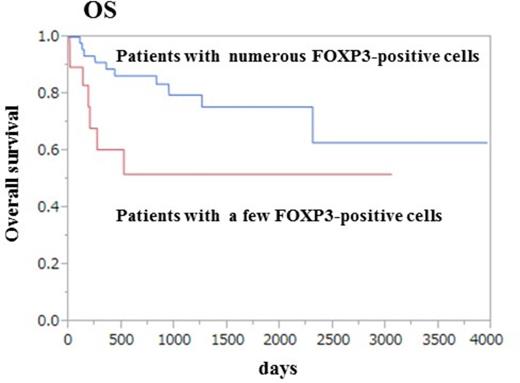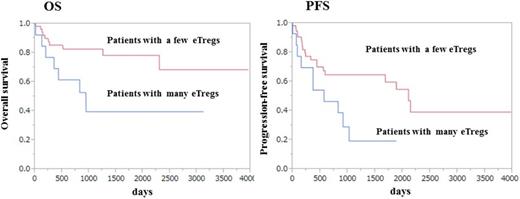Abstract
(Background) Regulatory T cells (Tregs) are the focus of interest as one of the tumor microenvironmental factors because of their critical role in the modification of immune response, such as suppression of tumor-associated antigen-reactive lymphocytes. Tregs-mediated immunosuppression contributes to the progression of tumors and poor prognosis of patients. Forkhead box P3 (FOXP3) had been regarded as a specific marker of Tregs, but recently, FOXP3-positive cells were proved to be heterogeneous in phenotype and function. FOXP3-positive cells include effector Tregs (eTregs), naïve Tregs, and non-Tregs. Of them, eTregs have a substantial immunosuppressive effect. So far, no study has investigated the relationship between infiltration of eTregs and prognosis of patients with lymphoma.
(Aim) The present study aimed to evaluate the relationship between infiltration of eTregs doubly positive for FOXP3/cytotoxic T-lymphocyte-associated antigen 4 (CTLA-4) and prognosis of patients with diffuse large B-cell lymphoma, not otherwise specified (DLBCL, NOS).
(Methods) Seventy-four DLBCL, NOS specimens were doubly immunostained with anti-FOXP3 and anti-CTLA-4 antibodies. The relationship between the degree of infiltration of only FOXP3-positive cells or FOXP3/CTLA-4 double-positive eTregs and the prognosis of DLBCL, NOS patients was analyzed using Cox regression analysis. (Results) Presence of numerous FOXP3-positive cells (>52x102/cm2) was significantly predictive of better prognosis than that of fewer FOXP3-positive cells (<52x102/cm2) in terms of overall survival (OS) (p =0.0481) (Figure 1). In contrast, presence of many eTregs (>18/cm2) was significantly predictive of worse prognosis than that of fewer eTregs (<18/cm2) in terms of OS and progression-free survival (p =0.0342 and p =0.0269, respectively) (Figure 2). This was independent of the international prognostic index.
(Conclusions) Higher infiltration of only FOXP3-positive cells showed better prognosis of DLBCL, NOS patients, consistent with existing reports. In contrast, higher infiltration of eTregs showed worse prognosis of DLBCL, NOS. This suggests that infiltrating eTregs play an important role in DLBCL, NOS progression. Recently, immunotherapies targeting eTregs-depletion or functional alteration of eTregs-are being developed and are being tried in some solid tumors. These immunotherapies could also become a novel strategy of treatment for DLBCL, NOS patients with higher eTregs infiltration.
Shoko:Osaka Community Foundation: Research Funding.
Author notes
Asterisk with author names denotes non-ASH members.



